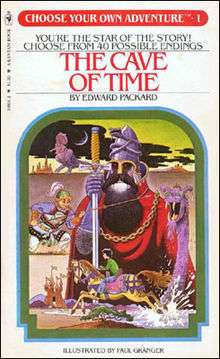Choose Your Own Adventure
 The Cave of Time by Edward Packard, the first book in the series. | |
| Cover artist | Paul Granger |
|---|---|
| Language | English |
| Genre | Gamebook |
| Publisher | Bantam Books |
| Published | 1979–1998 (original series) |
| Media type | |
| No. of books | 184 (original series) (List of books) |
Choose Your Own Adventure is a series of children's gamebooks where each story is written from a second-person point of view, with the reader assuming the role of the protagonist and making choices that determine the main character's actions and the plot's outcome. The series was based upon a concept created by Edward Packard and originally published by Constance Cappel's and R. A. Montgomery's Vermont Crossroads Press as the "Adventures of You" series, starting with Packard's Sugarcane Island in 1976.[1]
Choose Your Own Adventure, as published by Bantam Books, was one of the most popular children's series during the 1980s and 1990s, selling more than 250 million copies between 1979 and 1998.[2] When Bantam, now owned by Random House, allowed the Choose Your Own Adventure trademark to lapse, the series was relaunched by Chooseco, which now owns the CYOA trademark. Notably, Chooseco does not reissue titles by Packard, who has started his own imprint, U-Ventures.[3]
Format
Originally created for 7- to 14-year-olds, the books are written in the second person. The protagonist—that is, the reader—takes on a role relevant to the adventure; for example, private investigator, mountain climber, race car driver, doctor, or spy. Stories are generally gender and race neutral, though in some cases, particularly in illustrations, presumption of a male reader (the target demographic group) do appear.[4] In some stories, the protagonist is implied to be a child,[5] whereas in other stories, he/she is presumably a young adult.[5]
The stories are formatted so that, after a couple of pages of reading, the protagonist faces two or three options, each of which leads to more options, and then to one of many endings.[1] The number of endings is not set, and varies from as many as 44 in the early titles, to as few as 8 in later adventures. Likewise, there is no clear pattern among the various titles regarding the number of pages per ending, the ratio of good to bad endings, or the reader's progression backwards and forwards through the pages of the book. This allows for a realistic sense of unpredictability, and leads to the possibility of repeat readings, which is one of the distinguishing features of the books.[6]
As the series progressed, both Packard and Montgomery experimented with the gamebook format, sometimes introducing unexpected twists such as endless page loops or trick endings. Examples include the "paradise planet" ending in Inside UFO 54-40, which can only be reached by cheating or turning to the wrong page by accident, and the potentially endless storyline in Race Forever.[4]
History
According to Packard, the core idea for the series emerged from bedtime stories that he told to his daughters every night, revolving around a character named Pete and his adventures. Packard stated, "I had a character named Pete and I usually had him encountering all these different adventures on an isolated island. But that night I was running out of things for Pete to do, so I just asked what they would do." His two daughters came up with different paths for the story to take and Packard thought up an ending for each of the paths. "What really struck me was the natural enthusiasm they had for the idea. And I thought: 'Could I write this down?'"[1][7]
Packard soon developed this basic premise into a manuscript titled The Adventures of You on Sugar Cane Island. He set out in 1970 in order to find a publisher, but was rejected by nine different publishing companies, causing him to shelve the idea. In 1975, he was able to convince Ray Montgomery, co-owner of Vermont Crossroads Press, to publish the book and it sold 8,000 copies, a large amount for a small local publishing house. The series was later marketed to Pocket Books, where it also sold well, but Montgomery believed that it would sell better if a bigger publisher could be found for the books. After some discussion, Montgomery was able to make a contract for the series with Bantam Books. Packard and Montgomery were both selected to write books for the series, including the contracting out of titles to additional authors.[1][7]
The series was highly successful after it began printing with Bantam Books. It prompted the creation of three other series by different authors with Bantam Books that worked with the same format. Nineteen other series of the same format also began being published by rival publishing houses. The large popularity of the concept led to the titling of a new genre of writing for the format, which was called gamebooks.
See also
- Usborne Puzzle Adventure series
- Choose Your Own Adventure: The Abominable Snowman
- Fighting Fantasy
- Lone Wolf
- Give Yourself Goosebumps
- Interactive fiction
- List of Choose Your Own Adventure books
- Visual novel
References
- 1 2 3 4 Scott Kraft (October 10, 1981). "He Chose His Own Adventure". The Day. Retrieved March 15, 2011.
- ↑ Lodge, Sally (18 Jan 2007). "Chooseco Embarks on Its Own Adventure". Publishers Weekly. Archived from the original on 2007-10-09. Retrieved 2008-07-10.
- ↑ Conan, Neal. "'Choose Your Own Adventure' Gets An iMakeover". NPR News Transcripts. NPR. Retrieved 29 December 2012.
- 1 2 Hendrix, Grady. "Choose Your Own Adventure How The Cave of Time taught us to love interactive entertainment". Slate. Retrieved 29 December 2012.
- 1 2 Katz, Demian. "Demian's Gamebook Web Page". Retrieved 29 December 2012.
- ↑ Swinehart, Christian. "One Book, Many Readings". Retrieved 29 December 2012.
- 1 2 Sandi Scaffetti (March 30, 1986). "Interactive fiction". The Beaver County Times. Retrieved March 15, 2011.